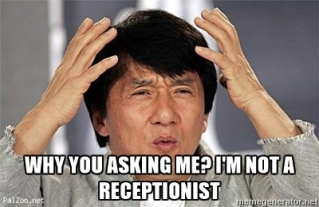This evening, at the ripe age of 24, I began my first television binge. My poison of choice was an animated series on Cartoon Network called Samurai Jack. Although I do not usually watch television shows, I was drawn to this one show by the same timeless trick that draw everyone to TV – advertising. Whenever I bike down Washington Street in Sommerville, I pass by the same promotional poster hanging in a bus-stop window. The poster is simple yet tantalizing – a single image of the series’ villain Aku on a plain black background; however, seeing this image once was enough to plant the seed of a childhood memory in my head, and seeing it a second time as we drove to dinner last night produced the intended reaction. So after an evening out with friends, I returned to my lonely computer life and began watching season 5, episode 1 of Samurai Jack.
 My first reaction was a mixture of repulsion and horror. During the opening scene, I cringed and nearly closed the window. What I saw was a shocking scene of carnage, gun-violence, and masochism. A man riding a motorcycle, strapped with a gun and knives, throwing himself upon an army of robot spiders who were menacing a defenseless pair of alien women. With each gun shot, spiked wheel piercing, and spear stab at the robots, limbs flew off and oily blood gushed out onto the battlefield.
My first reaction was a mixture of repulsion and horror. During the opening scene, I cringed and nearly closed the window. What I saw was a shocking scene of carnage, gun-violence, and masochism. A man riding a motorcycle, strapped with a gun and knives, throwing himself upon an army of robot spiders who were menacing a defenseless pair of alien women. With each gun shot, spiked wheel piercing, and spear stab at the robots, limbs flew off and oily blood gushed out onto the battlefield.
Despite my strong initial aversion, though, I was hooked. I even leaned in two or three times in an attempt to shut off the senseless bloodshed, violence that I knew was a terrible influence; nevertheless, I couldn’t overcome the draw of the animation and story.
And so I watched the entire set of released episodes in series 5, all 7 episodes back-to-back, totaling well over 3 hours. And I thoroughly enjoyed it.
If you haven’t experienced Samurai Jack before, it would be hard to describe how magical it is. Maybe it’s the brilliantly artistic animation, in which every scene is a work of art fit to be displayed in a gallery. Or maybe it’s the ingenious plot line, the mixes the hero myth with a clever half -sci-fi half-fantasy world. Perhaps it’s the cinematography, which dazzles us with widescreen shots, creative uses of darkness and light, and a phenomenal interplay of contrasting emotions. And maybe its the underlying human culture that permeates the world, with an emphasis on stereotypical Japanese traditional culture (tea ceremonies, samurai codes, etc…) but also extending into other mythologies, religions (Buddha-like figures, Jesus imagery), and world cultures (from Scottish warriors to Cambodian temple ruins).
Indeed, these reasons alone would all seem to point to the show’s inevitable success. But there is still one thing missing, the one reason I believe this show is so popular – validation. Validation of the things that are wrong with our American society.
However, the real kicker is that the messages that this show conveys, and undoubtedly one that is devoured by countless masses of our nation’s youth, are the same ones espoused by president Donald Trump and the Pornographic underworld of the internet.
Message 1 – women are objects
In the 7 episodes of Samurai Jack that I watched, there are two main roles for women.
1. Evil, brainwashed members of a cult of evil.
2. Women that have been saved by, and now idolize, a main male character. It’s no coincidence that all women are crafted with slim, unnaturally sexy physiques – the two outfit options are skin-tight black body suits or skimpy outfits that reveal much more cleavage and leg space than would ever be acceptable in any school.
 In addition to these pornographicly-aligned images, there are two situations that girl figures are subjected to: killed violently or chained up and toted around by the main male character like a backpack. There is one entire episode in which Jack hauls around one girl while she is bound in chains. And you can only guess which character speaks in philosophic monologues and witty quips and which character is stuck with minimalistic, dumbed-down speech.
In addition to these pornographicly-aligned images, there are two situations that girl figures are subjected to: killed violently or chained up and toted around by the main male character like a backpack. There is one entire episode in which Jack hauls around one girl while she is bound in chains. And you can only guess which character speaks in philosophic monologues and witty quips and which character is stuck with minimalistic, dumbed-down speech.
After hearing both Michelle Obama and Barack Obama in person denouncing our current president’s sexism and misogynistic views towards women, it is no wonder that Hillary was not elected – she didn’t provide enough validation.
Message 2 – desensitization to violence and killing
The most exciting part of Samurai Jack is the action – explosions, sword fights, punches, kicks, bombs, guns, tanks, missiles, arrows, chains, maces, axes, and general gravity-defying flips and leaps. However, this excitement also comes with carnage, bloodshed, and merciless murder. Lots of murder, from animals to aliens and people.
To be fair, the storyline begins to stigmatize murder as an “un-samurai thing to do”, but this is quickly deus-ex-machined by showing how the “good out-ways the bad”. So as long as you play your numbers right, murder can pay off in the long run.
The scariest part of desensitization to violence is that it can happen over just a few TV episodes. After seeing just one dramatic death of one of the 7 assassin sisters, the others could be dealt with with a quick spear or neck cracking, and it was all over with.
Now think about the largest recipients of funding after our recent election – Military, Military, Military. There is an undeniable connection between the acceptance of murder of “evil ones” for “the greater good” and the US military industrial complex. A further connection that may be less straightforward is that between cartoon violence and pornographic tendancies. According to the TedX talk by Ran Gavrieli, the pornographic industry can alter what arouses viewers by presenting images of violence (especially towards women). This kind of onscreen violence desensitizes the voyeristic viewer and helps promote the real-life sexual abuse and violence that are perpetrated around the world.
Message 3 – racial hegemony
For anyone who has ever seen a Hollywood movie, you know that the US is afraid of casting Asian leads. It’s called whitewashing, and you’ll know what I mean if you’ve ever seen Avatar the Last Airbender, Dragonball Evolution, 47 Ronin, The Great Wall, or any of the other countless Hollywood stories set in Asian contexts but with a white male lead. Sticking to this precedent, we see Samurai Jack as a scruffy, shirtless white dude for much of season 5.
 Although there are a handful of US minority races in minor roles in episode 6, the whitewashing is quite noticable.
Although there are a handful of US minority races in minor roles in episode 6, the whitewashing is quite noticable.
Noting needs to be said about the anti-minority xenophobic policies of the current head of the U.S. government.
Message 4 – a world of black and white
Finally, there is something disconcerting in the stark “good and evil” worldview presented in the series. Rather than trying to question, discuss, or debate, everyone in the Samurai Jack world seems polarized between the evil Aku side and the holy benevolance of Samurai Jack. It seems that the last assasain sister’s shift from Aku to Jack is simply swapping one blind-ideology for another. Rather than ever explaining why it is evil to build factories, to cut down trees, or to evict locals, the only explanation for wrong is that “Aku does it, so it must be stopped.”
So will I continue watching Samurai Jack? Probably not. But that’s not nearly as important as whether or not I can ever reclaim my mind from the violent, white-male dominated worldview that US media has been ingraining in me, and the nation’s youth, for years.
Sources:
Image 1 Aku – Pinterest
Image 2 – Breaking Canon
Image 3 – TVweb
Image 4- IGN.com












